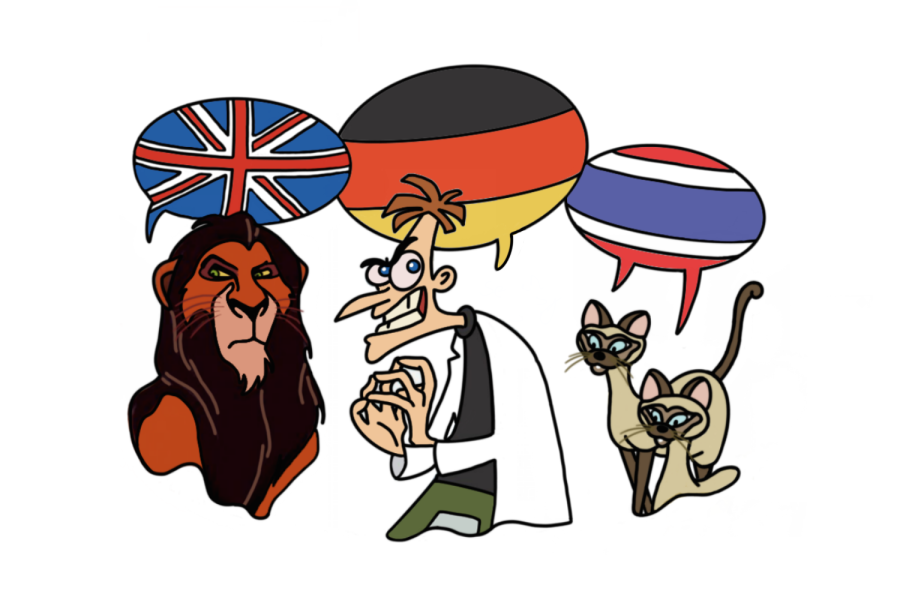Dear Disney, stop teaching kids that foreign accents are evil
Graphic illustration by Emma Constable
Movies and shows that deliberately portray villains with foreign accents are harmful to children’s perception of diverse cultures.
March 17, 2021
There is a rumor that cartoons directed toward children often hide a more sinister motive — brainwashing them to adopt a certain mindset or believe in certain principles so that they can be more easily controlled by the government. While this claim is wildly outlandish, it highlights how influential subliminal messages in children’s media can be, a notion which looms large over children’s cartoons today. The common practice of portraying villainous characters with foreign accents in American kids’ entertainment sends dangerous messages about diversity to children, shaping the way they perceive other cultures.
One of the most prolific sources of these characters is the Walt Disney Company, whose original animated films have captivated kids for decades.
“The stories were amazing,” sophomore Asmi Jamnis said. “The outfits attracted me every single time, and as a child I loved ‘Cinderella’ the most because that was the iconic princess story.”
However, beneath fairy tale endings and heartwarming lessons of friendship, dark patterns begin to emerge. It’s already apparent that the Disney classics contain a plethora of problems that don’t sit well with society today — some movies teach kids to equate beauty to “skin as white as snow,” for one, and they are consistently plagued by extreme underrepresentation of ethnic minorities. But purposefully playing into language tropes is on an entirely different level because it promotes negative cultural messaging in a more insidious, subconscious way. In addition to being exposed to primarily white protagonists in entertainment, kids learn to associate certain cultures and nationalities with “the bad guys.”
Even in early civilization, storytellers changed their voices to emulate other characters as an easy way for audience members to distinguish between different speakers. Modern children’s entertainment, unfortunately, has taken this to the extreme, repeating language tropes for villainous characters so consistently that young viewers have become dangerously vulnerable to developing ethnocentric views and an “us versus them” mentality.
Furthermore, such choices of characterization are clearly intentional given the contradictory context and location of stories. One prime example is the villain Scar in Disney’s classic “The Lion King.” Disney creators found it necessary not only to ignore the story’s cultural setting in the deserts of Africa, but also to voice Scar in a very distinct form of British English while Mufasa, his very own brother, has a completely American accent.
“I was confused the first time I watched it because I didn’t realize that they were brothers,” senior Ishan Saharoy said. “They look totally different, and they sound totally different.”
Many other Disney films are equally absurd: “Aladdin” is set in a mythical Arabian kingdom where all the main characters speak American English except for the evil sorcerer Jafar. “Lady and the Tramp” portrays the diabolical Siamese cat duo with Asian accents, while they would have us believe that countless breeds of dogs — which really do hail from different countries — all sound exactly the same.
Of course there are exceptions, such as the southern Tiana from “The Princess and the Frog” and Lumière from “Beauty and the Beast,” but these characters serve more to illuminate inconsistencies. After all, if an anthropomorphic candelabra’s speech is consistent with the story’s setting, why shouldn’t this apply to Belle and the Beast? Why is Quasimodo the opposite of French in “The Hunchback of Notre Dame”? And why, in “Pocahontas,” does John Smith appear to already have embraced his American identity while the rest of the Virginia Company are unmistakably British?
The list goes on and on, despite there being no reason for any of these villains to have foreign accents or for the protagonists to have strictly American ones. Children are visually adept and harbor strong notions of morality from a young age; do they really need to hear the difference between Mufasa and Scar to understand that the latter, whose entire characterization is built off his plot to kill Simba, is twisted and evil?
“Ever since I was small, I always considered [Disney] to be good and correct and that they did things on purpose to make the storyline interesting,” Jamnis said. “I never realized that the people who made those films had it in mind to portray different cultures in a certain way, which could be harmful because most kids think whatever is on TV is right.”
This problematic trend even manifests in popular non-Disney kids’ shows such as “Phineas and Ferb,” in which the wicked Dr. Doofenshmirtz hails from the Germanic land of Drusselstein; and “Kim Possible,” whose red-headed American heroine encounters a plethora of foreign bad guys — all with stereotypical accents. In 1998, Calvin Gidney and Julie Dubrow conducted a study analyzing over 1,500 characters from 30 different childrens’ television shows for trends in language tropes. Their findings — that none of the villains studied were portrayed with standard American English accents — are undoubtedly disturbing and an extreme cause for concern about what children are exposed to through their favorite cartoons.
“At least for young children, accent plays a larger role than do visual cues, such as skin color, in shaping preferences for who they want to be friends with,” said Jim McCloskey, a linguistics professor at UC Santa Cruz. “Children as young as five strongly prefer to be friends with peers who have the same accent as they do, so these dialect-based biases emerge very early in development.”
One reason why Disney and other entertainment companies rely so heavily on British English, German and Slavic dialects to characterize their villains is because these accents are considered to hold connotations of power, influence and intelligence. However, by integrating those stereotypes into kids’ entertainment, children are inevitably taught from an early age to think in the exact same way. Instead of forcing associations between foreign nationalities and villainy, film companies should extend those perceptions of power or intelligence to the agencies of a hero or heroine. Since Disney and others can assign these accents without a second thought to their animated agents of evil, they can just as easily reverse the status quo by assigning culturally diverse dialects to protagonists — not to mention doing justice to the very not-American countries in which these stories tend to take place.
Even now, that bias has turned to convention as modern childrens’ entertainment tends to emulate movies and shows that were popular in the past. Obviously, it goes without saying that it should not be the convention for children to learn to discriminate and stereotype through animated cartoons, so why does Disney keep churning out films that have yet to reflect an understanding of these harmful effects? The fact that this practice has persisted after countless decades is alarming because nearly every corner of American society today is marked by racism, discrimination and prejudice. Although this is an unfortunate reality, we have the power to change how bias surfaces among future generations by holding mainstream children’s media accountable.
Like so many other areas of life, this problem has been exacerbated by the current COVID-19 pandemic as television is now likely the prominent source of cultural messaging for young children due to their limited interaction with classmates.
According to McCloskey, humans instinctively use language to divide the people they meet and interact with into those who are in-group, or “one of us,” and out-group, or “not one of us,” where people identified as being in-group are generally considered to be more socially desirable, more intelligent and trustworthy. This tendency to divide people by audible differences is established as early as the age of five months, confirming that young children are susceptible to the harmful implications of foreign-sounding villains.
“The more exposure people have to out-group members the less likely they are to harbor prejudice against that out-group,” McCloskey said. “But it has to be meaningful contact and exposure — friendship, shared goals on a team, shared suffering and the like; casual and brief contact is not enough.”
With less opportunity to interact with culturally diverse peers and more time spent absorbed in front of the big screen, young viewers are thus at greater risk of developing harmful perceptions about others and themselves. While racial minorities who are represented as stereotypical villains are likely to have lower self-esteem, children who see themselves in American protagonists may subconsciously internalize negative feelings toward other nationalities.
Therefore, deliberately misrepresenting diverse cultures is even more harmful than excluding them altogether because it creates a negative image of foreigners rather than no image at all. We should be teaching kids that villains are “bad” because of their actions, not because of the way they speak. Film companies must recognize that America itself is an incredibly diverse mixture of different races, languages and cultures — not simply deny the value of diversity in every aspect of childrens’ development. As one of the primary storytellers for American children of all ethnicities, Disney in particular should use its reputation and influence to take bigger steps forward in reforming the negative dichotomy between Americanized cartoon protagonists and heavily-accented villains.
Parents and role models also have their own part to play. To prevent children from assimilating negative perceptions of culturally diverse groups, families should watch movies and shows together and have meaningful conversation about their perceptions, opinions and ideas. After all, it’s never too early to instill in children a concrete understanding of open-mindedness and anti-racism.
“Introducing diversity into films and media is very important because it shows kids that this is how it is,” Saharoy said. “It’s like: this is your culture, this is their culture, they both exist and that’s okay — that’s a much better way to imprint on kids how to think.”
Ultimately, the issue lies in the movies and shows whose characters come to life and embody specific ethnic groups. While more recent Disney films such as “Brave” seem to have somewhat addressed the disparity between cultural setting and character speech, the company as well as others have a long way to go. Until then, we can’t be convinced that “dreams really do come true.” Children want to see “a whole new world” — and they need to to see it untainted by bias.





































































Tina • Oct 10, 2023 at 10:56 pm
Thank you Emma for so eloquently and comprehensively getting this point across. Please can British actors STOP perpetuating this dangerous practice, the future consequences are going to be very serious.